
The Big Toe
It’s the Biggest Toe For a Reason
Take your shoes off…
I’ll wait…
Socks too.
Ok, look at your foot.
Which one is it more like?
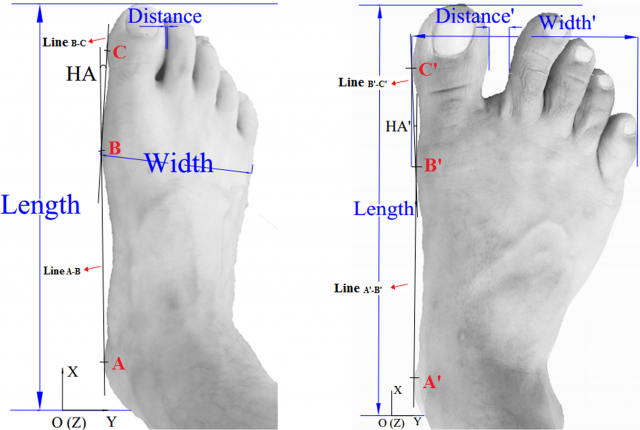
From: Foot Morphological Difference between Habitually Shod and Unshod Runners
The “crumpled up” one on the left, or the “splayed out” one on the right?
Look like the crumpled up one?
That’s what a lifetime in shoes does to you.
Unfortunately, crumpled up feet that look like this have become “normal” in todays society.
Just Cause It’s “Normal”, Doesn’t Mean It’s Right
At least not from an evolutionary standpoint.
We’re meant to have wide, splayed out feet.
“A logical prediction from an engineering view of an ideal foot is that a wider foot would offer a more stable base over which to pass the body weight, and a larger surface area over which to distribute pressure.” –Wilkinson and Saxby
Feet which take in sensory input from the ground and adjust toe-foot pressure and ankle position to influence gait, static and dynamic posture.
“the strength of the toes and somatosensory information from the sole and ankle are important during dynamic one-foot standing balance.” – All About Toe Pressures When Standing On One Foot
Wait, But What?
Yeah, your feet like all the other joints in your body should be:
STRONG and MOBILE
If they’re not, you’re losing strength, proprioception (balance) and postural integrity.
Yes, a non-functioning Big Toe leads to movement dysfunction and increased potential for injuries, not just at the foot and ankle but farther up the kinetic chain as well. <—-the joint by joint approach
Running Shoes, Orthotics and Insoles, Ohh My!!
Running shoes, tennis shoes, walking shoes, pronation control, arch support, heel lifts, heel cushioning, extra gel cushioning and motion control.
You mean to tell me, as bipedal animals, the part of the body MOST FREQUENTLY in contact with the ground evolved to be perpetually FUBARED?
Sorry, I’m not buying it.
Wed did something to F-the system up.
We call that thing,
SHOES
“habitual footwear use has significant effects on foot-related outcomes in all age groups, such as a reduction in foot arch and hallux angles. The results indicate an impact of habitual footwear use on the development of the feet of children and adolescents. Therefore, growing up barefoot or shod may play an important role for childhood foot development, implying long-term consequences for motor learning and health later in life.” –Growing up in or out of shoes
How many times did someone sell tell you, you “overpronate” or needed new/ better/ different shoes or the best one, Orthotics?
The line of thinking is,
“If we just brace your foot differently this time, everything will right itself.“
* Some people DO need orthotics, different shoes, etc. Some people are born with or develop real morphological pathologies that require intervention. But not everyone, sure as shit, not most people.
33 Joints, 26 Bones, 19 Muscles, 107 Ligaments in YOUR FOOT
Instead of the joints and muscles of the feet being mobile and strong, we stick our feet in thicker, higher topped, higher heeled, more padded, contoured, narrow toe boxed and arch supported casts shoes.
All trying to correct problems that being in casts shoes caused in the first place.
Yes, we’ve turned our feet, these wonderfully responsive, intricately constructed, structures that contain 33 joints into immobile CLUBS.
“Footwear particularly affects the kinematics and kinetics of gait acutely and chronically.”- Barefoot Vs Common Footwear
Yeah, so what you put on your feet changes the way you walk and how the body deals with those forces.
But Roy, My Plantar Fasciitis?
Did ya ever think for a minute, or better yet, did any “professional” ever float the idea that,
Your $100 running shoes are not preventing or treating your issue?
Maybe, at best, they’re managing your current state?
Did anyone ever propose:
“If your feet and ankles worked properly, your foot might distribute the forces properly and your chronic plantar fasciitis would resolve itself?”
Maybe, if you corrected the issue, which would take time and you may need these interventions to help manage the issue until it’s resolved, you wouldn’t need to get shoes with MORE padding or contour, I mean, “motion- control”
*I’m using plantar fasciitis here for an example, but you can insert many common foot/ ankle maladies.
I know this is pure heresy in the world of $20 Dr. Scholls inserts, $150 pronation control running shoes, and $300 orthotics.
Put the Torch Away For A Minute and Hear Me Out
Do you really overpronate?
Should you pronate?
Hell, what is pronation?
Is pronation even a bad thing?
Pronation Isn’t a Diagnosis, It’s a Necessity
If you don’t pronate, you’re foot isn’t functioning correctly.
“Donatelli described the following phases of gait during stance: heel contact, weight acceptance, midstance, push-off and propulsion, and toe-off. The gait cycle begins with the foot in a supinated position at heel strike. The subtalar joint then immediately pronates when going from heel strike to weight acceptance. This period of pronation results in the increased foot mobility needed to absorb ground reaction forces and adapt to uneven terrain. The foot reaches maximum pronation at the end of the weight-acceptance phase, and the subtalar joint supinates the foot from midstance through toe-off.26 This supination movement transforms the foot into the rigid lever arm needed for propulsion.” – Plantar Fasciitis and the Windlass Mechanism: A Biomechanical Link to Clinical Practice
Yes, OVERPRONATION is bad.
Just like excess movement at ANY joint is a bad thing.
“difficulties result when the joints of the foot are continually functioning beyond a normal end range. This can lead to greater stress along the medial joint capsules and ligamentous structures. Additionally, muscles such as the posterior tibialis can be in a lengthened position and are easily fatigued in an attempt to control excess motion. These stresses lead to pain, discomfort, and further lengthening. These authors concluded that plantar fasciitis results from the duration of motion and not merely from the motion itself.” – Plantar Fasciitis Study, same as above
So, maybe we should focus more on fixing the ACTUAL F-ING MECHANICAL CAUSE of the overpronation and less on a shoe, orthotic or insole that casts our foot more to limit the excess movement.
*Again, that’s 1000% not the case for everyone. Some people do need these interventions to function properly. But usually these interventions are only needed as adjuncts while fixing the problem(s). If you do the work, most people can reclaim the mobility and strength in their feet over time and will no longer require, or at least be, much less dependent on these interventions.
Can A Toe Really Be Great?
In this case?
Yes.
If you’re going to reclaim the strength and mobility of your feet you’re going to need to start with the Great Toe or Hallux.
Virtually all things foot function stem from the Hallux.
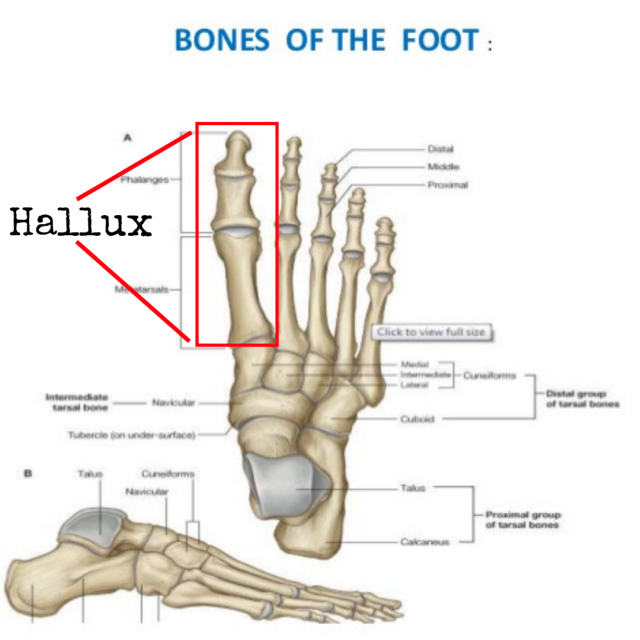 Pic stolen from (and modified by me) this slide show
Pic stolen from (and modified by me) this slide show
A mobile, strong, proprioceptive Hallux is vital for everything from balance, gait, distribution of forces along the kinetic chain to static and dynamic postures.
If the Great Toe doesn’t move, sense and react to the ground, and body position, bad things happen.
The great toe takes a disproportionately high load and role compared to the rest of the foot most of the time…
“In standing, the great toe exerts more pressure than those of the five metatarsal heads and the heel .”- Importance of the Great Toe in Balance Performance
“During walking, it (the great toe) poses twice the total pressure of the other four toes.” – Impact of Big Toe Amputation On Foot Biomechanics
Don’t Suck at The Balance Beam
You need inputs from the foot, all parts of the foot, to adjust foot pressure and manage the natural sway of the body in a single leg stance. <—-keep in mind every step you take involves a single leg stance.
But the Great Toe plays the biggest role,
“the toe is responsible for providing a stable surface area that remains in contact with the ground and serves to relay relevant sensory proprioception information to the central nervous system.” – The Effect on Human Balance of Standing With Toe Extension
If the Great Toe doesn’t move, adjust and respond to the pressures applied to it, the whole system gets screwy because you’re not getting the feedback and can’t make the necessary adjustments that you should be able to.
“constraining the great toe deteriorated the subjects’ single-leg stance performance and worsened the directional control ability during forward/backward weight shifting.”- The Role of the Great Toe in Balance Performance
Without a mobile Great Toe you’re unable to “grip the floor”, activating the arch of the foot and “rooting” yourself into the floor.
Instead your foot becomes passive and can’t make the micro-adjustments at the foot responding to the natural sway of the body.
“Since the great toe flexors were restricted while the toe was constrained, they can not participate fully in balance adjustment”- Lots of Smart Guys, I linked to before
Instead “macro-adjustments” in joint segments (ankle, knee and hip) above the foot must take place to balance effectively.
Walking Goes to Hell
Walking efficiently is highly dependent on taking advantage of the Windlass mechanism, which is an entire article in itself complicated, but it’s how your foot works,
The Windlass Mechanism involves the stretching out and “winding up” the plantar fascia while also remaining rigid enough to maintain foot structure and transfer that force through the foot at ground contact and push-off.
Amongst the primary mechanisms that make the Windlass mechanism work is dorsiflexion of the Hallux,
“This so-called windlass mechanism is of great importance since it tenses the plantar fascia thus forming a rigid lever of the foot for push-off. If the mechanism is altered, the timing and effectiveness of push-off would be affected. Therefore, disorders of great toe would cause inevitable changes in a subjects static and dynamic balance.“- The Mechanics of the Foot: The Plantar Aponeurosis and The Arch
If the Windlass mechanism isn’t functioning properly you’re walking like sh@t you’re losing a tremendous amount of power with each step and forcing compensations and adaptations at other joints along the kinetic chain.
“As the foot transitions from midstance into push-off, the toes begin to dorsiflex and the plantar fascia is activated. This activation of the plantar fascia upon hallux dorsiflexion is referred to as the “windlass mechanism” and is the second step in preparing the foot for propulsion.
Since power during propulsion is dependent upon the foot’s ability to become a rigid lever, ensuring proper hallux dorsiflexion during the gait is key to achieving full foot supination. Considering that during gait, the entire body is advancing past this single joint, the ability to dorsiflex, and subsequently raise the heel during single support phase while simultaneously supporting against the developing forces for forward motion is essential for normal, efficient gait. If this mechanism fails, sagittal plane compensation will be forced to occur . When the first MTP joint motion is disrupted enough to prevent stabilization of the foot structure during maximal hallux dorsiflexion, through the effect of the windlass mechanism, then normal foot stabilization during propulsion is disrupted, and becomes clinically significant”- Dr. James Spencer via Eric Cressey
What is sagittal plane compensation you ask?
Collapsing to the Midline.
Sagittal plane compensation could be falling outward, but that’s not what happens with an immobile Big Toe in real life.
Everyone I’ve ever seen collapses inward due to OVER-PRONATION at the foot, leading, or contributing to, excessive knee valgus.
“Insufficient muscular control of frontal- or transverse-plane hip motion during single-limb weight-bearing, for example, might be associated with excessive femoral adduction and internal rotation leading to knee valgus, tibial internal rotation, and excessive foot pronation” – Relationships Between Knee Valgus, Hip-Muscle Strength, and Hip-Muscle Recruitment During a Single-Limb Step-Down
But the most common problem with the big toe isn’t just that the Great Toe loses mobility.
The most common malady, one of the reasons the Big Toe loses mobility in the first place, one of the primary contributing factors to excessive pronation is…
Valgus Hallux, AKA: Bunions
Well, you’ve heard the term valgus before, and its not just knees that should stay aligned.
Valgus Hallux is a condition where the Great Toe has a lateral deviation at the first metatarsophalangeal (MTP) joint.
While it isn’t known if Valgus Hallux is a cause of gait overpronation, it is recognized that once valgus Hallux is present you’ll develop a greater degree of over-pronation further increasing the degree of deviation at the joint.
Just like Fat Bastard,
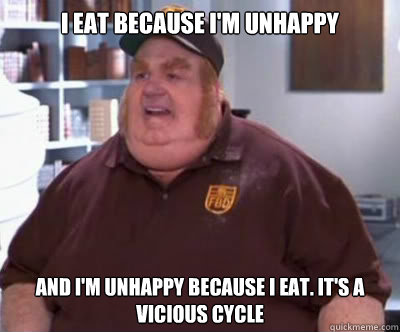
It’s A Vicious Cycle:
The worse the bunion <–> the more you overpronate <–> the more you overpronate <–> the worse the bunion gets <–> The more you overpronate
Unfortunately, I’ve seen this condition become increasingly normalized and accepted as, “normal” and “just a part of getting old”.
While bunions have become the most common foot malady,
“Hallux valgus is the commonest forefoot deformity, with an estimated prevalence of 23% to 35%”- Wulker and Mittag
Common Isn’t Normal, Normal is Normal
Why would we possibly think that the bodies natural response to walking is:
Deviate a Joint so we Make Walking Less Efficient?
Yes, despite the Windlass Mechanism, the added efficiency of Arm Swing, the Achilles Tendon.
All things that make walking MORE EFFICIENT.
Humans naturally developed, at their feet, the thing in contact with the ground, in a way to make walking LESS EFFICIENT?
LOGIC

In my opinion, bunions probably don’t “just happen”, at least not in most people.
Why do I think this?
Well, when we look at people who don’t habitually wear shoes
“Individuals that have been barefoot almost all their lives (habitually barefoot) seem to have wider feet as well as fewer foot and toe deformities. These habitually barefoot individuals have a higher foot arch and lower hallux angles compared to habitually shod individuals. This is in accordance with higher rates of differences in foot characteristics like flat feet and hallux valgus deformities in habitually shod populations. Furthermore, it is reported that the pliability of habitually shod feet is reduced compared to habitually barefoot ones.” – Growing up in or out of shoes
They tend not to get bunions (valgus Hallux)? <—some do, but the cases are far less common and the degree of deviation of the Hallux is substantially less.
Weird, I know.
Bind Your Feet = Get F@ckEd Up Feet
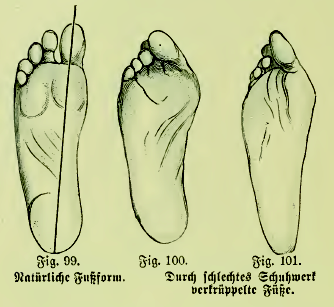 While some cases of Valgus Hallux are due to genetics and abnormal foot/ ankle mechanics, Valgus Hallux , at least to the severity and early onset I’ve seen it, is most commonly the result of habitually bad shoes.
While some cases of Valgus Hallux are due to genetics and abnormal foot/ ankle mechanics, Valgus Hallux , at least to the severity and early onset I’ve seen it, is most commonly the result of habitually bad shoes.
“In women it is not only narrow shoes that cause hallux valgus but also higher heels.” – High Heels as A Cause
In its later stages of Valgus Hallux there can be many changes to the boney and ligamentous structures of the foot.
Once you’re at that point?
You’re probably not going to fix yo nasty ass foot valgus hallux, without surgery.
Passive Treatments?
By themselves?
Probably not worth the effort either.
Orthotics:
Ahh, but they’re “custom-made”…
“treatment effects were maximal at 6 months and decreased thereafter. At 24 months, 43 (81%) patients continued to use the orthosis, with the median visual analogue scale score for patient satisfaction of 76 points. The hallux valgus angle and intermetatarsal angle did not change during the 24-month period.” –Effect of Orthoses on Valgus Hallux
To be fair, in the above study, overall pain decreased, but never resolved, and the Hallux angle hadn’t improved in 24 months.
Yes, the orthotic made walking less painful, a good thing for sure.
But didn’t actually help fix the underlying issue one bit.
Night Splints and Toe Spreaders:
The hallux valgus angle and intermetatarsal angle decreased in both groups; however, the reduction was not significant. According to the results of this study, using night splint seems to have no effect on painful hallux valgus deformity. On the other hand, although the insole with toe separator significantly decreased the pain intensity in these patients and was a good option for pain reduction, it was not effective in improvement of the great toe angles. – Night Splints Vs Toe-Spreaders
Again, at least with the toe spreader, we got a decrease in pain and the Hallux angle did improve some.
But none of it was worth writing home about.
Let me reiterate something real fast:
If you’re in pain, and an intervention gets you OUT OF PAIN.
That’s a damn good intervention….for pain.
I’m not knocking orthotics, splints or toe spreaders.
All of them can be really helpful are effective as PART of the treatment plan.
What I’m saying is that duck tape doesn’t actually fix anything.
The Problems With Only Using Passive Modalities
#1: The mobility of the WHOLE FOOT isn’t taken into account.
Too many interventions are just about using this or that thing.
The mobility/ pliability/ alignment of the whole foot isn’t treated/ improved.
Feet kind of have to synchronize all 33 joints to work together.
If you’ve got a Big Toe that’s literal pushed under the second toe, don’t you think the rest of the foot had to compensate?
#2: The muscles, ligaments and tendons of the foot never get stronger in passive treatments.
None of these interventions make the muscles of the foot do anything.
They’re just realigning or casting the feet to artificially create joint angles or limit motion.
Passive modalities are not helping the muscles of the feet to actually become more active and stronger, allowing for better force production, absorption and control of the foot.
Derek Zoolander
Seriously, that’s what researching this article made me think of.
Who The Hell Treats Anything Without Using BOTH Active and Passive Modalities?
Wouldn’t it just make sense to use BOTH options together?
I think so.
And it works, at least if the Valgus Hallux is mild to moderate?
Recent studies have shown, that at least someone out there is using their brain, treating the feet like every other part of the body, finally using a combination of passive and active means to treat bunions.
“All patients in the treatment group had been treated with mobilization for all the joints of the foot, strengthening exercises for the plantar flexion and abduction of the hallux, toe grip strength, stretching for ankle dorsiflexion, plus use of a toe separator.
Patients who were treated with 3 months of foot mobilization and exercise program combined with the use of a toe separator experienced greater improvement in pain 2.4±1, AOFAS score, ankle range of motion 74.5±2, plantar flexion and abduction of the hallux strength, toe grip strength, and radiographic angular measurements, than those who did not receive an intervention, at both 3 months and one year post-intervention
The effect of these results support the use of a ‘multi-faceted conservative intervention’ to treat moderate hallux valgus, – Women With Bunions Do Stuff to Fix Em
“Surprise, Surprise, Surprise”- Gomer Pyle
Incredibly, integrated, multi-faceted treatment, involving active foot mobility, strengthening and passive “retraining” modalities had a positive effect.
Mind blown, I know.
So what’s that mean for you?
You might not be destined to have feet that resemble your grandmothers.
There’s something you can do to improve the situation, but it’s gonna be work.
And for the long haul.
*BTW: Just so we’re all on the same page.
It’s not that I think insoles, orthotic or shoes for that matter are worthless or inherently detrimental.
No, I wear shoes all the time. They do cool things like keep your feet warm and safe and dry.
What I do think is that: you should spend more time out of shoes, work your way down to the most minimalist shoes you can handle the most often, and really try to limit the time spent in Fancy Dan shoes like narrowed toe boots or high heels. <—-More on that next time.
Orthotics and Insoles and such: Can be SUPER valuable.
They can get people out of pain and if pain is present you cant really do the work to un-fudge your feet, cause, well, they hurt.
Plus you can’t go from heel lifted-fully supported “basketball” shoe to minimalist “clown toe” shoes overnight without issues.
This is the actual warming that comes with New Balance Minimus shoes (my personal favorite and what I have on right now).
Your feet and ankles just wont be prepared (mobile and strong) enough to handle that.
What I really think is, we should only use duct tape when necessary.
But should work on fixing the actual problem and not needing the duct tape, or just needing less of it, long-term.

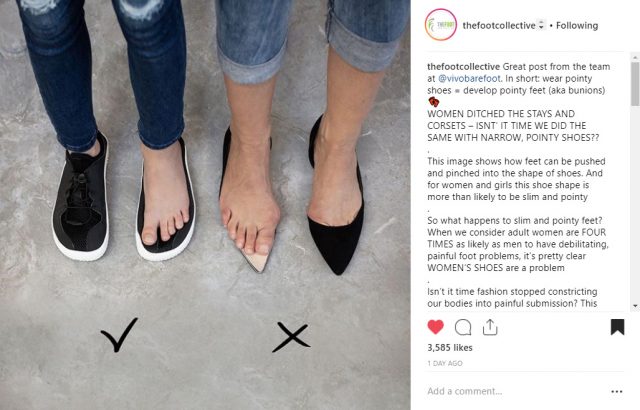
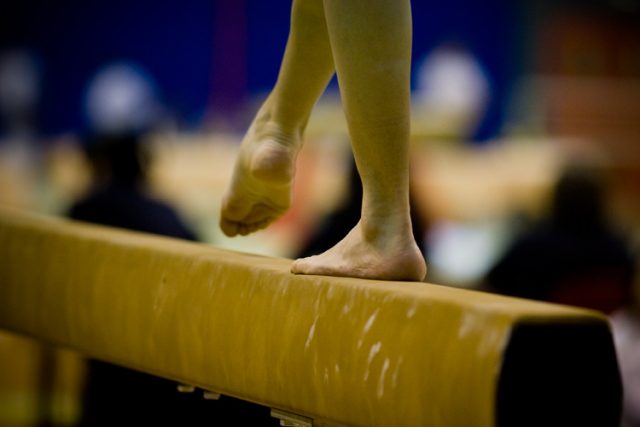

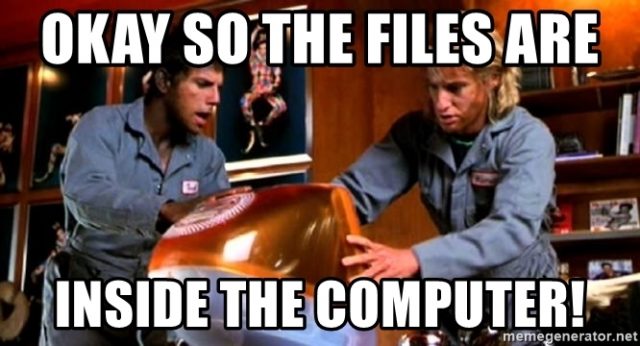
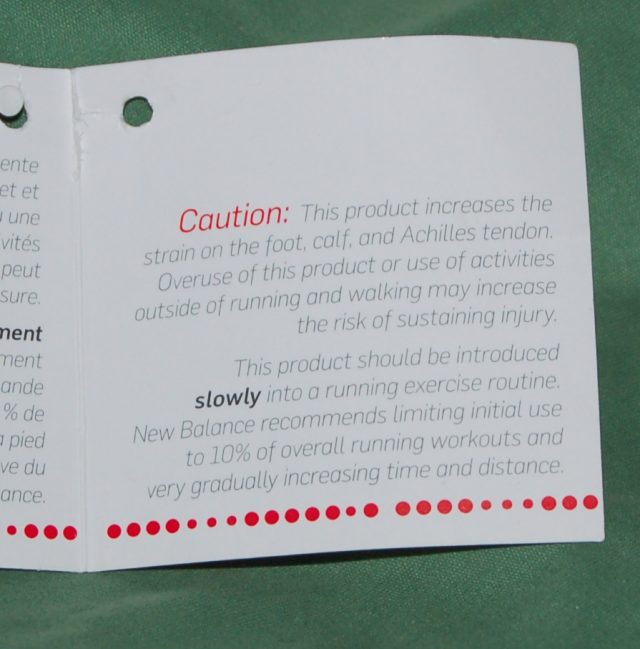


[…] Your Big Toe needs to move. <—-as we learned in Part one, which you can read by clicking the link The Greatness of the Great Toe […]